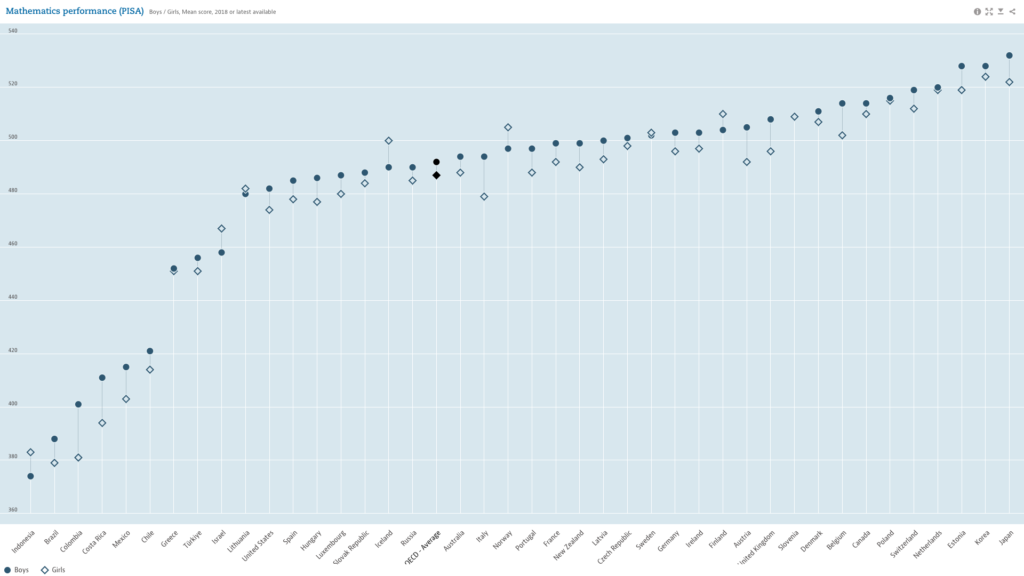Global Math Assessments
Beginning this fall, American students will participate in a global math study, known as the Programme for International Student Assessment (PISA). Beginning in 2000, this study is given every 3 years, however it was delayed due to the Covid-19 pandemic, so the tests being given this fall are occurring 4 years after the 2018 results. PISA actually takes a look at reading and science, in addition to math, testing 15-year-old students across roughly 80 countries.
Every PISA test year has a focus on one of these 3 disciplines, and this year the focus is math, with an additional test of creative thinking. After several pilot tests last spring, the new PISA 2022 test is in progress this fall. PISA is administrated by the Organization for Economic Cooperation and Development (OECD), which represents 80+ industrialized countries across the globe.
By design, PISA tries to measure how well students complete real-world tasks, both in and out of school.
PISA 2018 Mathematics Results by Country
As you can see in the 2018 PISA performance rankings below, the US is in the bottom third for industrialized nations. Note that in only a few countries did girls test better than boys, with most countries, including the US, showing inequality between the sexes. Girls did notably better than boys in the Nordic countries of Finland, Norway, and Iceland.

U.S. ranks near the bottom
According to PISA 2018, the United States scored below the OECD average for math proficiency. On a scale of 0–1,000, the average score in math proficiency among education systems ranged from 592 in China to 326 in the Dominican Republic. The US scored 478, while the OECD average was 489. This below-average score for the US put it below many Asian countries and autonomous areas, like Hong Kong, Japan, and Korea. It also puts the US significantly behind other western nations, like nearly all of Europe, Estonia, the UK, and Canada. Unfortunately, this isn’t new territory for American 15-year-olds, because America has been bouncing along the below-average scores for 20 years, since the PISA test began. In fact, while US math scores have not been declining, there’s also been no detectable change in since 2003.
Despite these low math scores, Americans seem to be in denial. In several studies of attitudes towards math readiness on the global stage, most Americans don’t see any problems, and many actually believe American students have comparable math skills to their foreign peers. According to a 2008 survey by the Associated Press, nearly 50 percent of Americans erroneously believed that American students were doing well in math, even thought most of them admitted that education helped improve economic growth. Americans who believe their schools are excellent also tend to feel that other schools in their area don’t measure up.
National Assessment of Educational Progress (NAEP) scores in math routinely show that only one-third of American 8th graders are proficient in math. A US News and World Report article by veteran teacher Elie Venezky remarked in 2018 that there’s a small silver lining…at least math scores have not been declining in the past few decades (with the exception of the pandemic, of course). In other words, the US is consistently terrible on average. One US student population is seeing math scores actually improve, and that’s the top quartile of students. However, the achievement gap is widening, and bottom 10th percentile has lost ground, and most student populations have not seen improvements.
US students not only test poorly in math, but the U.S. does poorly compared to other countries in teaching math. For example, the average fourth grader in the U.S. is expected to know about 40% of what he or she needs to know to succeed in high school. This compares to 70% in France, 80% in South Korea and 90% in New Zealand.
Let's Go Learn's diagnostic assessments
With Let’s Go Learn, you can create personalized instruction that inspires success for each learner, as you differentiate curriculum for intervention, remediation, and enrichment.
Why are American Students Doing Poorly in Math?
What can be done to help U.S. students improve average math scores? Most pundits point to the way math is taught. And it’s not the teachers who are the problem; it’s the tests. Venezky wrote, “too much of our instruction is based on getting as much information into kids heads as quickly as possible, because standards must be met and tests must be taken.” The problem with this strategy is that kids don’t learn what’s driving the math, or how to apply. They instead develop a superficial knowledge of math fine-tuned to specific summative tests. Venezky continues, “Math is a language which builds on itself, and not understanding the foundations of math is like not understanding the structure of a language.”
Two big obvious constraints on teaching are time and money, and both may need to be increased if we expect math scores to improve. Teachers need to have the resources and ability to differentiate students, acknowledging the fact that every student learns differently. Academic achievement is often only possible when the teacher is supported by the administrators, the school board, and the community.
One easy solution is to use detailed diagnostic assessments to determine the strengths and weaknesses of each student. Then, if a student’s math foundation is incomplete in some area, the teacher knows this and can plan accordingly. Let’s Go Learn provides the high-quality diagnostic math assessments to do this. Schools and teachers may not be able to improve class sizes themselves, but if students are differentiated into groups who can work through problems together, with some guidance from teachers and assistants, this ameliorates the negative impacts of large class sizes.
One school, Benjamin Franklin Elementary in Connecticut, even bucked the national learning loss trend through the pandemic by keeping average math scores up. They did this by devoting more class time to math, even before the pandemic began. Younger kids at the school have more than an hour a day of math instruction, while the older kids have as much as 90 minutes, which is much higher than most US elementary schools. The school also utilizes instructional differentiation and the flipped classroom model, where little time is spent lecturing the entire classroom, and more time is spent working on problems in small groups.
Interestingly, spending time with digital technology is also not the problem. While use of digital technology has skyrocketed amongst students in the past decade, especially during the pandemic, this use does not correlate negatively with math scores. Some parents in the U.S. blame digital technology for the learning loss during the Covid-19 pandemic, but the problem is not the digital technology itself but HOW that technology was used. Sitting children down for 5 hours a day in front of a screen, trying to replicate classroom best practices with teachers who have never taught online before, was a recipe for disaster. But using digital technology to supplement good teaching is a winning strategy.
Using pre-pandemic data, several high performing nations in the PISA international math scores have children who spend amongst the highest number of hours per week on the internet. In Denmark and Sweden, students report spending more than 45 hours per week online. Students in the US are also amongst the biggest users of the internet at 41 hours per week, but our math outcomes are radically different than the Scandinavian countries.
Why should math scores matter?
Stanford research Eric Hanushek famously looked at global student math scores over a 50-year period, and together with Ludger Woessman of the University of Munich showed a causal relationship between PISA test scores and a country’s GDP.
“With respect to magnitude, one standard deviation in test scores (measured at the OECD student level) is associated with an average annual growth rate in GDP per capita two percentage points higher over the forty years that we observe.” (The Knowledge Capital of Nations by Hanushek and Woessman 2015, p.44).
This much growth in a country’s GDP is important, because even a few percentage points of growth could pay for all of primary and secondary education. So this idea inspired many U.S. leaders, notably George H.W. Bush, to set to work on the task of improving math scores. But then how do we explain the collapse of the Soviet Union, or the economic troubles of Japan, both of whom enjoy perpetually high ranks in the PISA math test? If we can raise math scores, is U.S. economic output guaranteed to go up?
While most experts still believe math scores are important, some researchers take a more nuanced approach. Japanese researchers Hikaru Komatsu and Jeremy Rappleye have shown that the relationship between math scores and GDP output is not as continuously causal as originally thought. Connecting math scores with such huge impacts is frought with variables from all sorts of non-academic influences on GDP, including pandemics.
Still, the benefits of improving math scores are clear. Levin and Belfield note that there are, “substantial economic benefits from raising mathematics skills in high school.” Specifically, they note these benefits to the individual students, high school graduation rates, the taxpayer, and society as a whole. Social revolutions can outweigh academic improvements. But that doesn’t mean we should be satisfied with existing PISA scores. America can do better, and the tools are available. A good place to start would be diagnostic assessments and progress monitoring for every student.
References
- https://nces.ed.gov/surveys/pisa/overview.asp
- https://data.oecd.org/pisa/mathematics-performance-pisa.htm
- https://read.oecd-ilibrary.org/education/21st-century-readers_a83d84cb-en#page22
- https://www.thebalancemoney.com/the-u-s-is-losing-its-competitive-advantage-3306225
- https://www.usnews.com/news/best-countries/articles/2018-05-04/commentary-heres-why-the-united-states-is-so-bad-at-math
- https://www.nytimes.com/2019/12/03/us/us-students-international-test-scores.html
- https://www.nytimes.com/2022/10/15/us/math-student-achievement-pandemic.html
- https://www.washingtonpost.com/news/answer-sheet/wp/2017/04/27/is-there-really-a-link-between-test-scores-and-americas-economic-future/
- https://www.tandfonline.com/doi/full/10.1080/03050068.2017.1300008
- https://repository.upenn.edu/cgi/viewcontent.cgi?article=1029&context=cbcse



Leave A Comment